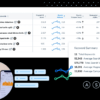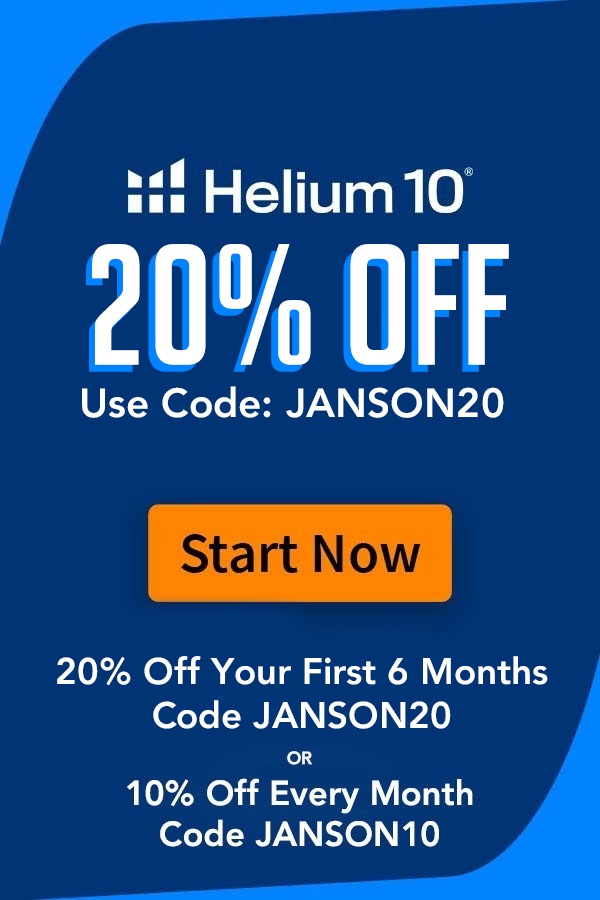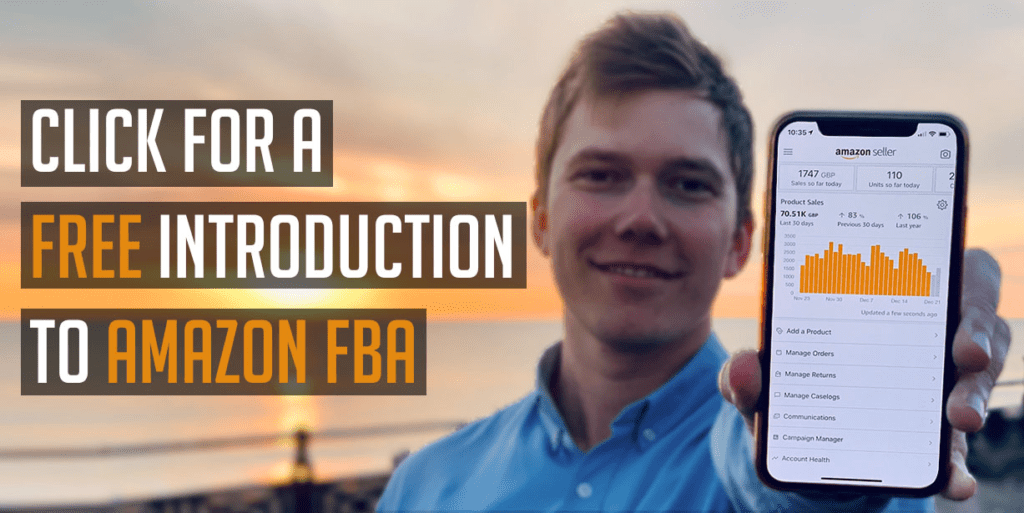
If you’ve just dipped your toes into the world of Amazon FBA and you’re looking to learn as quickly as possible how you can make your first £10,000 selling your own products, then get your notepad and pen out because we’re going to be running through a step-by-step guide to Amazon FBA success: get setup, learn how to do Amazon FBA product research, and to start selling so that you can start earning. If you’ve not come across me before, I’m a 7-figure Amazon FBA seller and I practice what I preach – so all of the steps that you’re going to be running through I myself have taken them, and the proof is in the pudding – here’s a photo of my sales from the last 30 days.
So, let’s dive into my blueprint for how to make your first 10k on Amazon FBA.
Stage 1: Getting Your Business Set Up
Every seller needs an Amazon seller’s account, an in order to get one of those you’re going to need to have your own business – either a limited company or a sole trader. Most people choose to be a limited company that’s because it’s more efficient when it comes to extracting cash – i.e. you’ll be paying less tax. If you want to learn more about the differences between the two, check out this video here.
Setting up a limited company might sound like a difficult and overwhelming task, but it’s actually pretty straightforward and cheap to do. Option 1, is to head to government’s limited company creation site, fill out the form and then pay £12, or option 2 is to get a company like Osome to do it for you.
Osome are a digital accounting firm that specializes in working with Amazon FBA sellers and if you use this link, there’s an offer for them to create they’ll do all of the work for you, for just £1.

Regardless of whether you choose to become a limited company or operate as a sole trader, you’re going to need an accountant, so it’s well worth speaking with Osome in any event.
Once you’ve got your limited company setup you’ll be able to set up a business bank account, which is required if you want to start selling on Amazon. Whilst there are plenty of options out there for you to choose from, in my experience a lot of them are slow & often reject new businesses that haven’t started trading yet, which is kinda ridiculous when you think about it. To avoid pulling out all of your hair in frustration whenever you get a rejection, my advice is to skip the high street banks and go for a digital bank such as Tide or Wise, both of which are accepted by Amazon.
As soon as your application is approved and you’ve got your account number, sort code and debit card ready, you can move onto the more exciting part of the process, which is creating your Amazon sellers account.
Stage 2: Creating Your Amazon Seller’s Account
Whilst you might think that the process of creating an Amazon Seller’s account is going to be a piece of cake, don’t get too complacent – because the process of registering for a seller account does trip a lot of people up, resulting in them being blocked from selling before they’ve even started. So here are two of my biggest tips to stop that happening to you.
Firstly, when asked what type of seller you are, select either sole proprietor – which means sole trader, or private entity – which means you are a limited company.
The other answers 99 times out of a 100 will not be relevant to you and should not be selected.
Secondly, whenever you fill anything out in the application form, whether it be your name, your date of birth, or your address, make sure you triple check that there are no spelling mistakes, and that all of your details match. Failing to do that will mean that you won’t pass verification and therefore you’ll be unable to sell. But, provided that you take your time when filling out the registration form, and you ensure that you have your bank details, company name and debit card to hand, you should be accepted and ready to start selling in no time at all.
Stage 3: Searching For Your £10,000 Product
Finding an Amazon FBA product to sell is more than likely going to take you at least 2 or 3 weeks, because learning the different methods and thought processes behind product research takes time. There are plenty of techniques that you can follow in order to discover different product ideas, and one of my favorite methods is with Helium 10’s Black Box tool, which is a bit like Google, except instead of being shown websites, you’re shown products.
To use it, simply create an account with Helium 10, which you can currently do for free using my link, login, and then browse to the Black Box tool. Select the categories that you like the look of, input the target monthly revenue and price point of the product that you want to sell, and then press search. You’ll then be shown lots of different product ideas that have existing demand on Amazon, which acts as a great starting point for the next stage of the journey to making your first £10,000, which is verifying whether the product that you’ve found is going to be profitable and give you an opportunity to improve upon the existing offering.

Stage 4: Verifying Your Amazon FBA Product Will Be A Smash Hit!
No matter what product it is that you want to sell on Amazon, if you want to achieve success then you absolutely need to ensure that the product has 1) demand and customers are buying it on Amazon 2) a profit margin of least 15%, and 3) an opportunity for you to improve upon the existing offering from other sellers. If you’re scratching your head wondering how you might go about verifying whether a product that you’ve found meets all of these criteria, then don’t worry because some of it’s actually easier than you might think.
To assess the sales demand of any product on Amazon, simply download Helium 10’s chrome extension, search for your product and then press the Helium 10 X-Ray button. You’ll then be presented with a pop up that will tell you exactly how many units are being sold each month by every seller, as well as how much money they’re generating. Ideally, the minimum amount of sales that you should expect to see, should be 3x your monthly profit target. To verify profitability, you can simply search for your product on a supplier website such as Alibaba, and ask a supplier for the unit price, and then use my free profit calculator to see how much money you’re likely to make for each sale you make.

The hardest part of product research is the third piece of essential criteria , which is finding an opportunity to improve. There’s no easy way to go about this other than to put in the time, look through your competitions listings, and then whether you think things like the quality their product, listing, branding and so on can be improved and beaten by you.
If you manage to find a product that ticks my three essential criteria of demand, profitability and improvement, then you’ve potentially found yourself the product that is going to be helping you generate your first £10,000.
Stage 5: Ordering From A Good Supplier
Once you’ve found something that you want to sell, you’re going to need to find a good Amazon supplier that not only makes a high quality product, but also has a good level of English and responds quickly. Most suppliers in the eastern world will advertise their services on a website called Alibaba. So, search for your product on there, message as many suppliers as you can find, ask for product samples, and then once you’ve received them, assess the quality, rank each supplier by price, communication and quality, and based on all three of those decide which supplier you want to move forward with for your main order.
In terms of your order size, that’s going to come down to your budget and what you’re comfortable spending. Ideally for your first order you should have at least 2 months worth of stock, so use Helium 10’s X-Ray tool to assess what that’s likely to be, and then determine whether you’re comfortable ordering that amount, or if you want to reduce it slightly.
Stage 6: Making Your £10,000 Amazon Product’s Listing
Every product that is sold on Amazon needs to have a product listing, which comprises of a title, summary bullet points, description and pictures – all items that the customer will look through before deciding whether they want to make a purchase. When putting your product’s listing together, don’t be tempted to jam in a load of keywords that don’t make sense in an attempt to improve your product’s SEO and visibility.
Think about the problems that your product solves, why the customer should choose you over your competition, and then write that down in a compelling and logical manner. Of course, including relevant keywords is an important task to do, but it must make sense. If you need help understanding the best keywords to include throughout your listing, use Helium 10’s keyword and listing optimisation tools.
As the saying goes, a picture is worth a 1000 words, so when designing your products images, don’t skimp and go for low quality. Instead, hire a local photographer in the area or a use a 3D render designer of Fiverr to get some high quality pictures of your product, and then use the services of an image editor to put together a set of compelling images that will make the customer desperate to buy. You can usually find talented designers on sites such as Fiverr and Upwork, just be sure to check their reviews & portfolio before you go ahead and hire somebody.
Stage 7: Sending Your £10,000 Product To Amazon
Typically when an order is placed with a supplier, they’ll request a deposit from you up front, and that can vary from 30-50% based on the product and the supplier. Your final balancing payment will then be due once the goods are ready for dispatch, which could be anywhere from 4 to 8 weeks later depending on how many units you’ve ordered and the complexity of the product being manufactured. If you found your supplier on Alibaba then you can pay your deposit with your credit card for an extra layer of protection, or a cheaper way is to do a bank transfer with a bank such as Wise.
Once your supplier has confirmed the goods are ready for dispatch and you’ve made the final payment, you’ll need to tell Amazon that your product is ready and its on its way to their warehouse . To do this, log into Seller Central, browse to the shipments tab, and then click ‘send to Amazon’.

Input the number of units that you’re sending, and the weight and dimensions of each box that’ll be holding your product, and once you’ve completed that, you’ll be given Amazon’s shipping labels, that you’ll need to send to your supplier to stick onto each box. If you’re unsure how many boxes being sent and the dimensions and weight of each, ask your supplier to send you their packing list, which is a sheet that will contain all of the relevant shipping information.
You’ll need to arrange the transport and shipment of your product which you can do through a shipping agent or freight forwarder, or if you’d rather take the slightly more expensive but more convenient route, just ask your supplier if they can arrange it instead.
Depending on whether you choose to ship by air or sea, your product should arrive at Amazon’s warehouse within 2-6 weeks, and once it does, you’ll receive an email notification saying that your goods have been checked in, and that in a matter of days you’ll soon be an official amazon seller.
Stage 8: Launching Your £10,000 Product On Amazon
After a couple of days of waiting for Amazon to receive your product, a number of units should become available to customers to purchase.
Once that happens, you’ll need to do a number of things to increase your product’s visibility and conversion in order to drive sales and profitability.
First of all you’ll need to try to get a few product reviews, which you can do by enrolling into Amazon’s Vine programme, or if you don’t mind breaking a rule or two, subtly asking a few distant friends and family to buy the product and leave a review. Reviews play a huge part in how successful a product is, so if you can get a couple lined up and published in your first week of selling, then the number of customers browsing your listing and then deciding to buy should increase by a noticeable amount.
To get your product seen by as many people as possible, you’ll need to make use of Amazon’s advertising platform, which is Pay Per Click, i.e. you’re only charged for an ad once a customer clicks on your listing. If you’re new to advertising on Amazon and you’ve never experienced PPC before, my advice is to create an automatic campaign, which essentially lets Amazon determine when and where you appear in search results.
If you’re a bit more advanced and you have experience of advertising on other platforms, then you can start to look at manual campaign types. Start with a modest budget of £10 or $10 per day, and review your campaign’s performance each day by looking at the keywords that are getting you the most clicks. If they’re irrelevant or costing too much, then you can remove them from your campaigns so you don’t get charged for them anymore.
Finally, to increase your product’s conversion even further during your launch period, my advice is to start selling with a lower price point versus your competitors. If you can give customers immediate reasons to buy through your high quality listing AND offer them an amazing product at an attractive price point, they’ll be left with no choice but to purchase from you, increasing your sales and your conversion, which will ultimately contribute to you appearing higher in the search results and generating more profits over time.
Stage 9: Reordering
Once you’ve successfully started selling your product on Amazon, you’ll quickly need to decide if the product’s sales have matched your expectations – or have the potential to – and whether you’ll be placing a subsequent order with your supplier. You should have enough sales data to make a decision on this within 3 or 4 weeks, so to avoid running out of stock and having to go through a re-launch, have a chat with your supplier, provide any feedback from customer reviews that could make the product even better, and then discuss re-ordering.
It’s always worth trying to negotiate a better price with your supplier on your second order, which they may be open to if you’ve managed to build some sort of relationship. A second order should ideally be sized so that you’re able to stay in stock for at least 2 months, so calculate what this is likely to be, determine if you can afford it and if you’re comfortable, and then place your second order. A second order is likely to be much more profitable than your first given you’ll have some reviews, an organic rank position and hopefully have ironed out any issues leading to refund requests, so just bear that in mind when assessing whether you want to go ahead with a follow up order.
Stage 10: Recording Sales & Calculating Profitability
Keeping on top of your business’s sales and profitability is an essential step to take, so make sure that you review your sales and the profit that you’re making every day or every week at the very least. You can do this manually with the use of my free profit calculator which I’ll link below, or an easier and more accurate way is using a tool such as Shopkeeper, which will calculate your profit after every single fee that there is.
If you find that you’re not making as many sales or as much profit as you expected, you’ll need to find the route cause and then fix the problem. Common issues that I come across for underperformance are a poor quality listing that doesn’t communicate the benefits of the product well, an offer that isn’t compelling enough to give the customer a reason to buy from you versus the competition, a price point that isn’t attractive enough, or an advertising campaign that is overspending on irrelevant keywords.
The good news is that all of these can be fixed, but it may take some time and effort. When you do identify any problems, get to work on solving them, so that you can turn your performance around and take your product to your first £10,000.
After following those 10 steps that I’ve just run through, there’s no reason why you won’t be able to hit that awesome milestone of £10,000 from selling products on Amazon. While it might seem like a lot to take in and something that’s quite difficult to follow, believe me, once you’ve gone through the process you’ll look back and realize how simple it all actually is. I started selling with Amazon FBA in 2018 with zero experience and creativity, and I’ve since gone on to grow my business to generate 6 figures of profit per year. If I can do it, so can you.
To help increase the chances of you hitting that £10,000 milestone with your first product, you can download my Amazon seller step by step checklist for free.
For more beginner guides, read my guide to make money with Amazon FBA with just one product.
If you want to learn how you can create an Amazon FBA business yourself, then check out my free training where I’ll teach you everything you need to launch your first product on Amazon and scale to $5,000+ in monthly profit.
Or if you’re ready to begin your journey and want to start with the best chances of success, apply to become a member of HonestFBA’s training programme where you’ll receive guidance & support from our team of 7-figure Amazon FBA seller experts whenever you need it.





